Performance Optimization and Exergy Analysis of Thermoelectric Heat Recovery System for Gas Turbine Power Plants
Abstract
:1. Introduction
2. Methodology and Computational Models
2.1. Thermoelectric Modeling
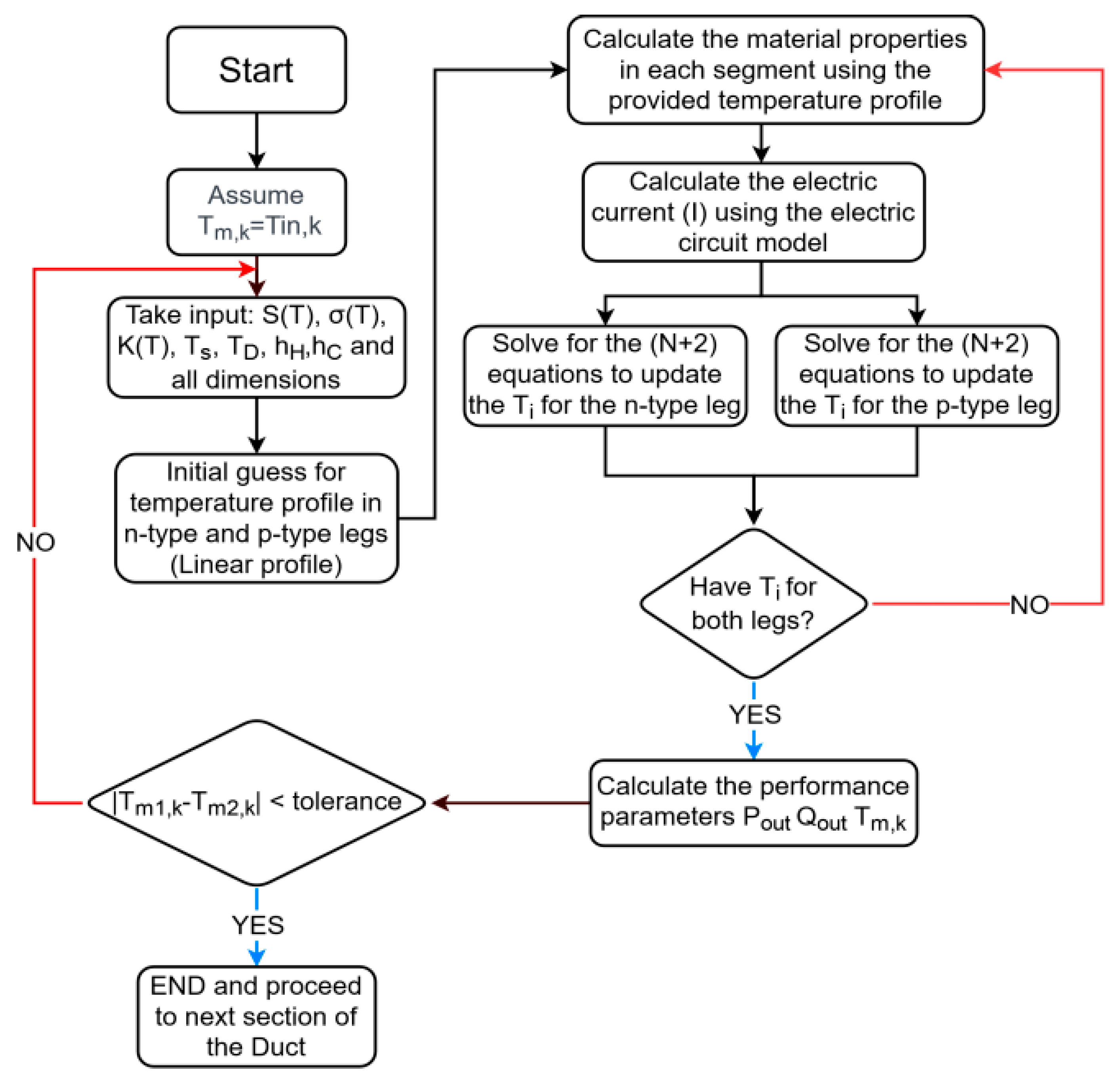
2.2. Exergy Analysis
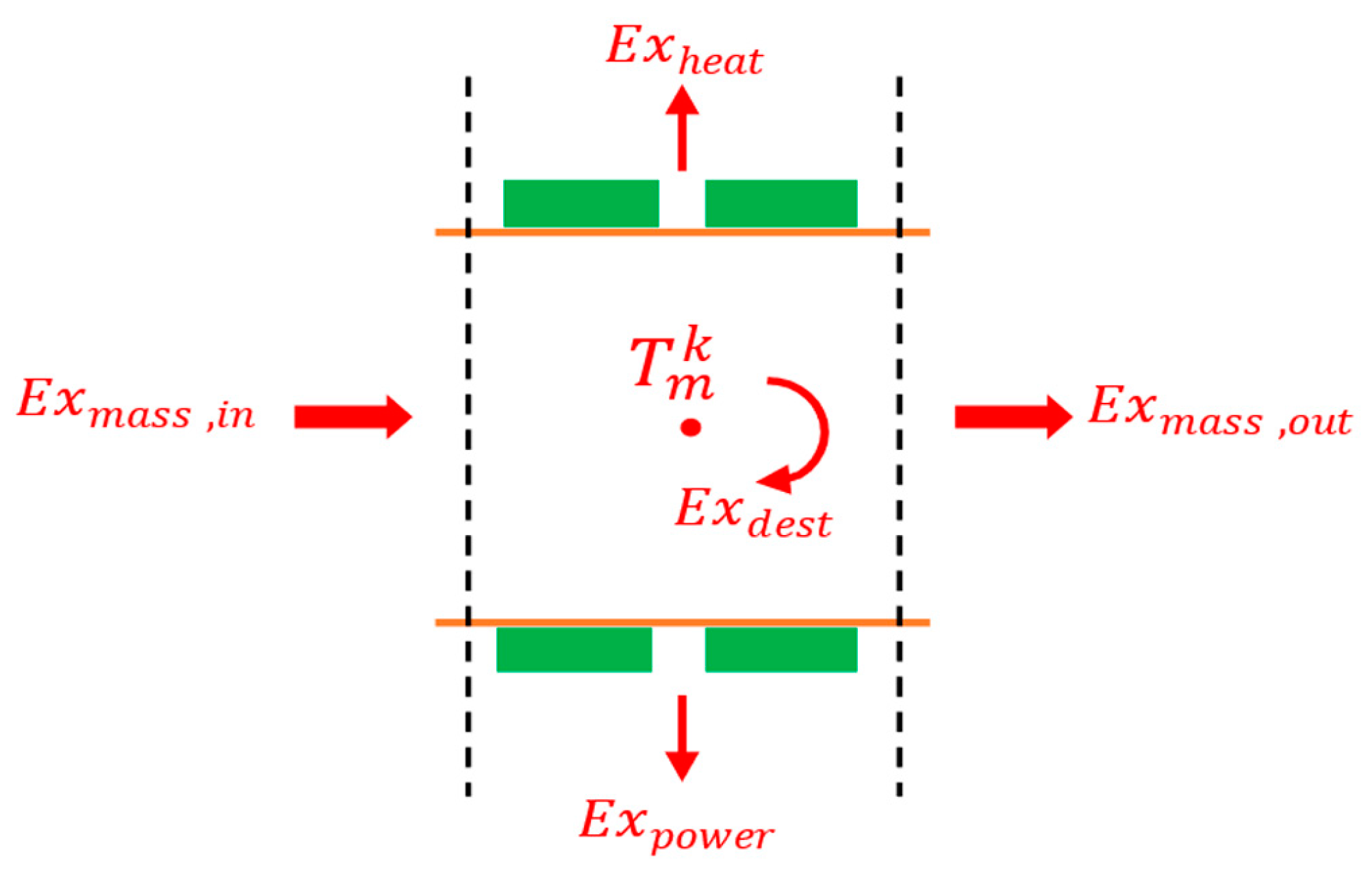
2.3. Economic Analysis
3. Results and Discussion
3.1. Power Generation Performance
3.2. Results of Exergy Analysis
3.3. Effects of Convective Heat Transfer Coefficients
4. Conclusions
Author Contributions
Funding
Institutional Review Board Statement
Data Availability Statement
Conflicts of Interest
Nomenclature
| Area of the n-type leg | |
| Area of the p-type leg | |
| Total surface area | |
| Hydraulic diameter | |
| Destructed exergy | |
| Exergy input | |
| Exergy input to TE | |
| Exergy output | |
| Useful exergy output | |
| Total wasted exergy | |
| Fill Factor | |
| Cold side convection coefficient | |
| Hot side convection coefficient | |
| Electrical current | |
| Number of TE pairs | |
| Rate of heat transfer | |
| Seebeck coefficient | |
| Entropy input | |
| Entropy output | |
| Absolute temperature | |
| Boundary temperature | |
| Cold temperature | |
| Temperature of exhaust gases | |
| Temperature of the ith segment | |
| Temperature of the jth node | |
| Mean temperature of the kth section of the exhaust duct | |
| μ | Fluid velocity |
| ZT | Thermoelectric figure of merit |
| α | Thermal diffusivity |
| 2nd law efficiency | |
| Electrical conductivity | |
| Kinematic viscosity | |
| Electrical conductivity |
References
- Zahedi, A. Maximizing solar PV energy penetration using energy storage technology. Renew. Sustain. Energy Rev. 2011, 15, 866–870. [Google Scholar] [CrossRef]
- Forman, C.; Muritala, I.K.; Pardemann, R.; Meyer, B. Estimating the global waste heat potential. Renew. Sustain. Energy Rev. 2016, 57, 1568–1579. [Google Scholar] [CrossRef]
- Lawrence Livermore Nat. Lab. Estimated U.S Energy Consumption in 2021. Available online: https://flowcharts.llnl.gov/ (accessed on 9 October 2023).
- Olabi, A.; Elsaid, K.; Sayed, E.T.; Mahmoud, M.S.; Wilberforce, T.; Hassiba, R.J.; Abdelkareem, M.A. Application of nanofluids for enhanced waste heat recovery: A review. Nano Energy 2021, 84, 105871. [Google Scholar] [CrossRef]
- Cengel, Y.A.; Boles, M.A.; Kanoğlu, M. Thermodynamics: An Engineering Approach, 5th ed.; McGraw-hill: New York, NY, USA, 2011; pp. 507–513. [Google Scholar]
- Breeze, P. Gas-Turbine Power Generation; Academic Press: Cambridge, MA, USA, 2016; pp. 41–42. [Google Scholar]
- Moran, M.J.; Shapiro, H.N.; Boettner, D.D.; Bailey, M.B. Fundamentals of Engineering Thermodynamics; John Wiley & Sons: Hoboken, NJ, USA, 2010; pp. 539–543. [Google Scholar]
- Raj, N.T.; Iniyan, S.; Goic, R. A review of renewable energy based cogeneration technologies. Renew. Sustain. Energy Rev. 2011, 15, 3640–3648. [Google Scholar] [CrossRef]
- Najjar, Y.S. Gas turbine cogeneration systems: A review of some novel cycles. Appl. Therm. Eng. 2000, 20, 179–197. [Google Scholar] [CrossRef]
- Bell, L.E. Cooling, heating, generating power, and recovering waste heat with thermoelectric systems. Science 2008, 321, 1457–1461. [Google Scholar] [CrossRef] [PubMed]
- Zabrocki, K.; Goupil, C.; Ouerdane, H.; Apertet, Y.; Seifert, W.; Müller, E. Continuum theory of TE elements. In Continuum Theory and Modeling of Thermoelectric Elements; Goupil, C., Ed.; Wiley-VCH: Weinheim, Germany, 2016; pp. 75–156. [Google Scholar]
- Liu, Z.; Gao, W.; Oshima, H.; Nagase, K.; Lee, C.-H.; Mori, T. Maximizing the performance of n-type Mg3Bi2 based materials for room-temperature power generation and thermoelectric cooling. Nat. Commun. 2022, 13, 1120. [Google Scholar] [CrossRef]
- Snyder, G.J.; Toberer, E.S. Complex thermoelectric materials. Nat. Mater. 2008, 7, 105–114. [Google Scholar] [CrossRef]
- Yan, X.; Poudel, B.; Ma, Y.; Liu, W.; Joshi, G.; Wang, H.; Lan, Y.; Wang, D.; Chen, G.; Ren, Z. Experimental studies on anisotropic thermoelectric properties and structures of n-type Bi2Te2.7Se0.3. Nano Lett. 2010, 10, 3373–3378. [Google Scholar] [CrossRef]
- Poudel, B.; Hao, Q.; Ma, Y.; Lan, Y.; Minnich, A.; Yu, B.; Yan, X.; Wang, D.; Muto, A.; Vashaee, D. High-thermoelectric performance of nanostructured bismuth antimony telluride bulk alloys. Science 2008, 320, 634–638. [Google Scholar] [CrossRef]
- Li, J.; Zhang, X.; Chen, Z.; Lin, S.; Li, W.; Shen, J.; Witting, I.T.; Faghaninia, A.; Chen, Y.; Jain, A. Low-symmetry rhombohedral GeTe thermoelectrics. Joule 2018, 2, 976–987. [Google Scholar] [CrossRef]
- Zhao, L.-D.; Lo, S.-H.; Zhang, Y.; Sun, H.; Tan, G.; Uher, C.; Wolverton, C.; Dravid, V.P.; Kanatzidis, M.G. Ultralow thermal conductivity and high thermoelectric figure of merit in SnSe crystals. Nature 2014, 508, 373–377. [Google Scholar] [CrossRef]
- Chen, G.; Dresselhaus, M.; Dresselhaus, G.; Fleurial, J.-P.; Caillat, T. Recent developments in thermoelectric materials. Int. Mater. Rev. 2003, 48, 45–66. [Google Scholar] [CrossRef]
- Gayner, C.; Kar, K.K. Recent advances in thermoelectric materials. Prog. Mater. Sci. 2016, 83, 330–382. [Google Scholar] [CrossRef]
- Kuroki, T.; Kabeya, K.; Makino, K.; Kajihara, T.; Kaibe, H.; Hachiuma, H.; Matsuno, H.; Fujibayashi, A. Thermoelectric generation using waste heat in steel works. J. Electron. Mater. 2014, 43, 2405–2410. [Google Scholar] [CrossRef]
- Ghosh, S.; Margatan, K.; Ahn, C.H.; Bahk, J.-H. Radiant heat recovery by thermoelectric generators: A theoretical case-study on hot steel casting. Energy Convers. Manag. 2018, 175, 327–336. [Google Scholar] [CrossRef]
- Yazawa, K.; Koh, Y.R.; Shakouri, A. Optimization of thermoelectric topping combined steam turbine cycles for energy economy. Appl. Energy 2013, 109, 1–9. [Google Scholar] [CrossRef]
- Yazawa, K.; Hao, M.; Wu, B.; Silaen, A.K.; Zhou, C.Q.; Fisher, T.S.; Shakouri, A. Thermoelectric topping cycles for power plants to eliminate cooling water consumption. Energy Convers. Manag. 2014, 84, 244–252. [Google Scholar] [CrossRef]
- Hasani, M.; Rahbar, N. Application of thermoelectric cooler as a power generator in waste heat recovery from a PEM fuel cell–an experimental study. Int. J. Hydrogen Energy 2015, 40, 15040–15051. [Google Scholar] [CrossRef]
- Lai, C.; Zhao, Q.; Zhang, Z.; Zhang, H.; Hou, S.; Zhao, J. Potential evaluation of flexible annular thermoelectric generator in photovoltaic system performance improvement: Energy and exergy perspectives. Energy Convers. Manag. 2021, 247, 114711. [Google Scholar] [CrossRef]
- Hsu, C.-T.; Won, C.-C.; Chu, H.-S.; Hwang, J.-D. A case study of thermoelectric generator application on rotary cement furnace. In Proceedings of the 2013 8th International Microsystems, Packaging, Assembly and Circuits Technology Conference (IMPACT), Taipei, Taiwan, 22–25 October 2013; IEEE: New York, NY, USA, 2013; pp. 78–81. [Google Scholar]
- Luo, Q.; Li, P.; Cai, L.; Zhou, P.; Tang, D.; Zhai, P.; Zhang, Q. A thermoelectric waste-heat-recovery system for portland cement rotary kilns. J. Electron. Mater. 2015, 44, 1750–1762. [Google Scholar] [CrossRef]
- Sztekler, K.; Wojciechowski, K.; Komorowski, M.; Tarnowska, M. The thermoelectric generators use for waste heat utilization from cement plant. In Proceedings of the E3S Web of Conferences; EDP Sciences: Les Ulis, France, 2017; p. 01031. [Google Scholar]
- Mirhosseini, M.; Rezania, A.; Rosendahl, L. Harvesting waste heat from cement kiln shell by thermoelectric system. Energy 2019, 168, 358–369. [Google Scholar] [CrossRef]
- Mirhosseini, M.; Rezania, A.; Rosendahl, L. Power optimization and economic evaluation of thermoelectric waste heat recovery system around a rotary cement kiln. J. Clean. Prod. 2019, 232, 1321–1334. [Google Scholar] [CrossRef]
- Araiz, M.; Casi, Á.; Catalán, L.; Martínez, Á.; Astrain, D. Prospects of waste-heat recovery from a real industry using thermoelectric generators: Economic and power output analysis. Energy Convers. Manag. 2020, 205, 112376. [Google Scholar] [CrossRef]
- Yang, J.; Stabler, F.R. Automotive applications of thermoelectric materials. J. Electron. Mater. 2009, 38, 1245. [Google Scholar] [CrossRef]
- Hsiao, Y.; Chang, W.; Chen, S. A mathematic model of thermoelectric module with applications on waste heat recovery from automobile engine. Energy 2010, 35, 1447–1454. [Google Scholar] [CrossRef]
- Luo, D.; Sun, Z.; Wang, R. Performance investigation of a thermoelectric generator system applied in automobile exhaust waste heat recovery. Energy 2022, 238, 121816. [Google Scholar] [CrossRef]
- Orr, B.; Akbarzadeh, A.; Lappas, P. An exhaust heat recovery system utilising thermoelectric generators and heat pipes. Appl. Therm. Eng. 2017, 126, 1185–1190. [Google Scholar] [CrossRef]
- Wu, Y.; Zhang, H.; Zuo, L. Thermoelectric energy harvesting for the gas turbine sensing and monitoring system. Energy Convers. Manag. 2018, 157, 215–223. [Google Scholar] [CrossRef]
- Brady Knowles, C.; Lee, H. Optimized working conditions for a thermoelectric generator as a topping cycle for gas turbines. J. Appl. Phys. 2012, 112, 073515. [Google Scholar] [CrossRef]
- Aydin, H. Exergetic sustainability analysis of LM6000 gas turbine power plant with steam cycle. Energy 2013, 57, 766–774. [Google Scholar] [CrossRef]
- Cengel, Y.A. Heat Transfer: A Practical Approach, 2nd ed.; McGraw-Hill: New York, NY, USA, 1998; pp. 441–443. [Google Scholar]
- Araiz, M.; Martínez, A.; Astrain, D.; Aranguren, P. Experimental and computational study on thermoelectric generators using thermosyphons with phase change as heat exchangers. Energy Convers. Manag. 2017, 137, 155–164. [Google Scholar] [CrossRef]
- Zhao, Y.; Wang, S.; Ge, M.; Li, Y.; Yang, Y. Energy and exergy analysis of thermoelectric generator system with humidified flue gas. Energy Convers. Manag. 2018, 156, 140–149. [Google Scholar] [CrossRef]
- Kraemer, D.; Jie, Q.; McEnaney, K.; Cao, F.; Liu, W.; Weinstein, L.A.; Loomis, J.; Ren, Z.; Chen, G. Concentrating solar thermoelectric generators with a peak efficiency of 7.4%. Nat. Energy 2016, 1, 16153. [Google Scholar] [CrossRef]
- Goldsmid, H.J. Bismuth telluride and its alloys as materials for thermoelectric generation. Materials 2014, 7, 2577–2592. [Google Scholar] [CrossRef] [PubMed]
- Chen, Z.; Xu, G.; Chen, S.; Zhang, J.; Wang, M. Hydrothermal synthesized nanostructure Bi–Sb–Te thermoelectric materials. J. Alloys Compd. 2014, 588, 384–387. [Google Scholar] [CrossRef]
- Wang, S.; Qiu, Y.; Zhao, L.-D. BiSbSe3: A promising Te-free thermoelectric material. Appl. Phys. Lett. 2023, 122, 260503. [Google Scholar] [CrossRef]
- Yazawa, K.; Shakouri, A. Optimization of power and efficiency of thermoelectric devices with asymmetric thermal contacts. J. Appl. Phys. 2012, 111, 024509. [Google Scholar] [CrossRef]

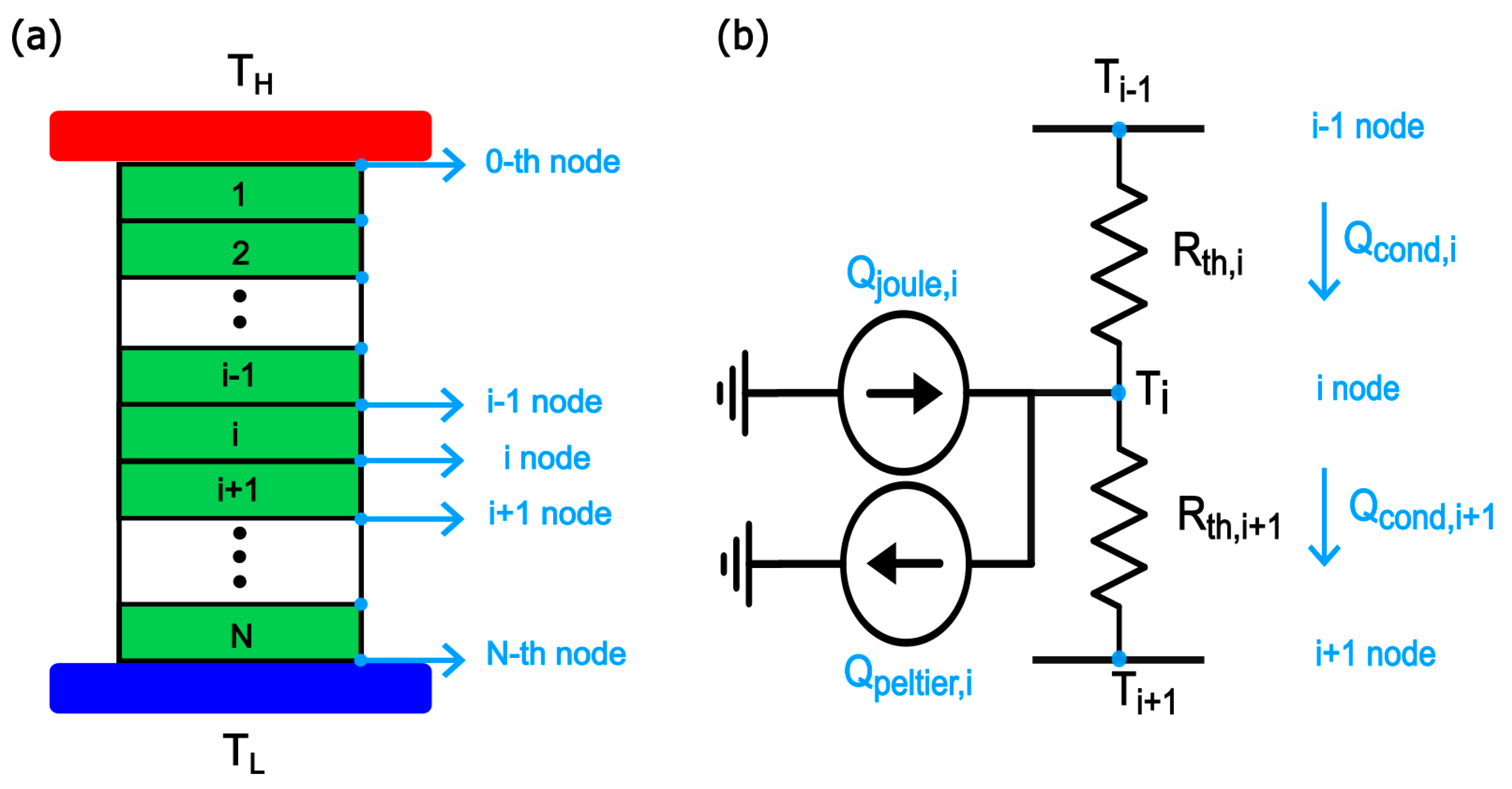

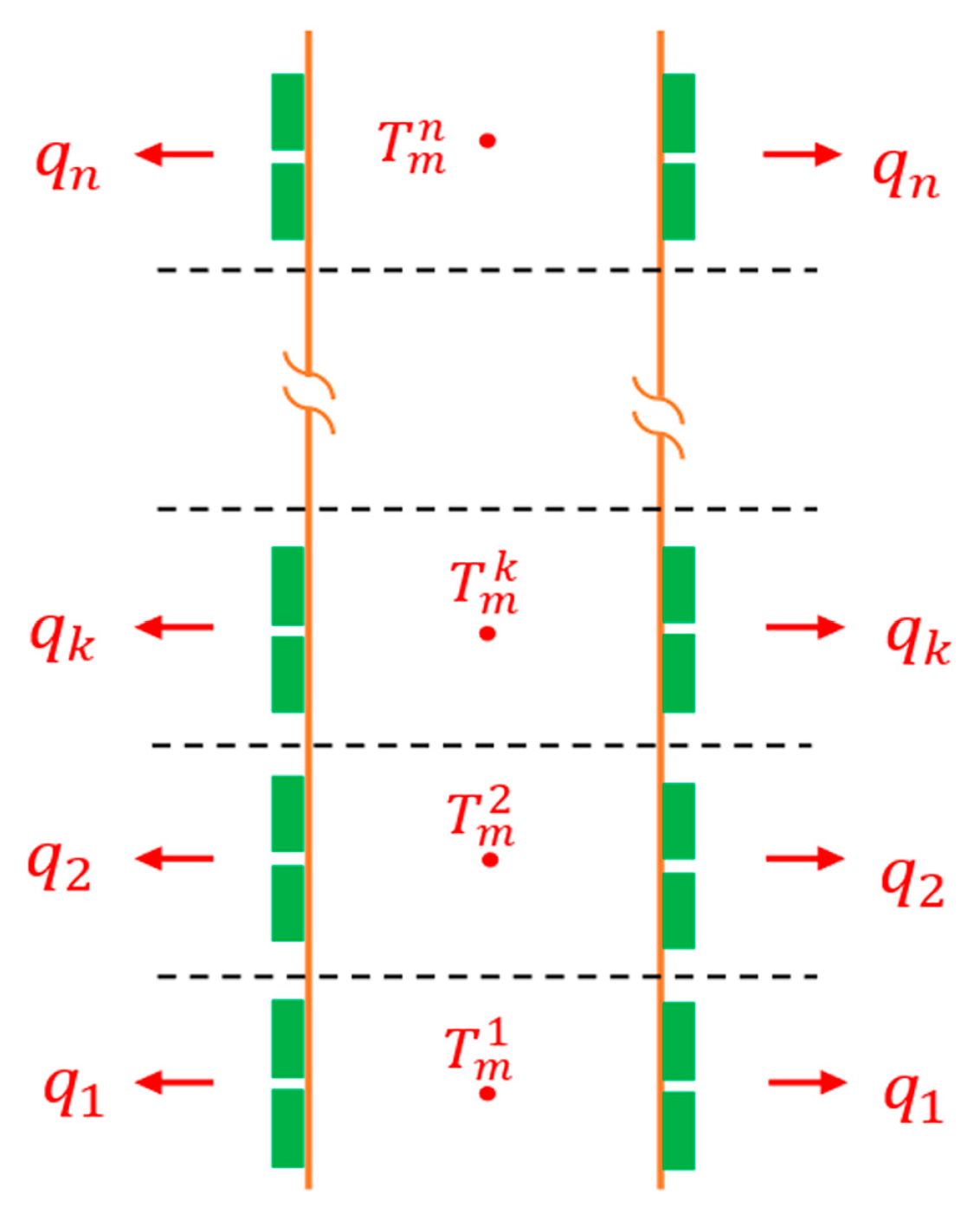
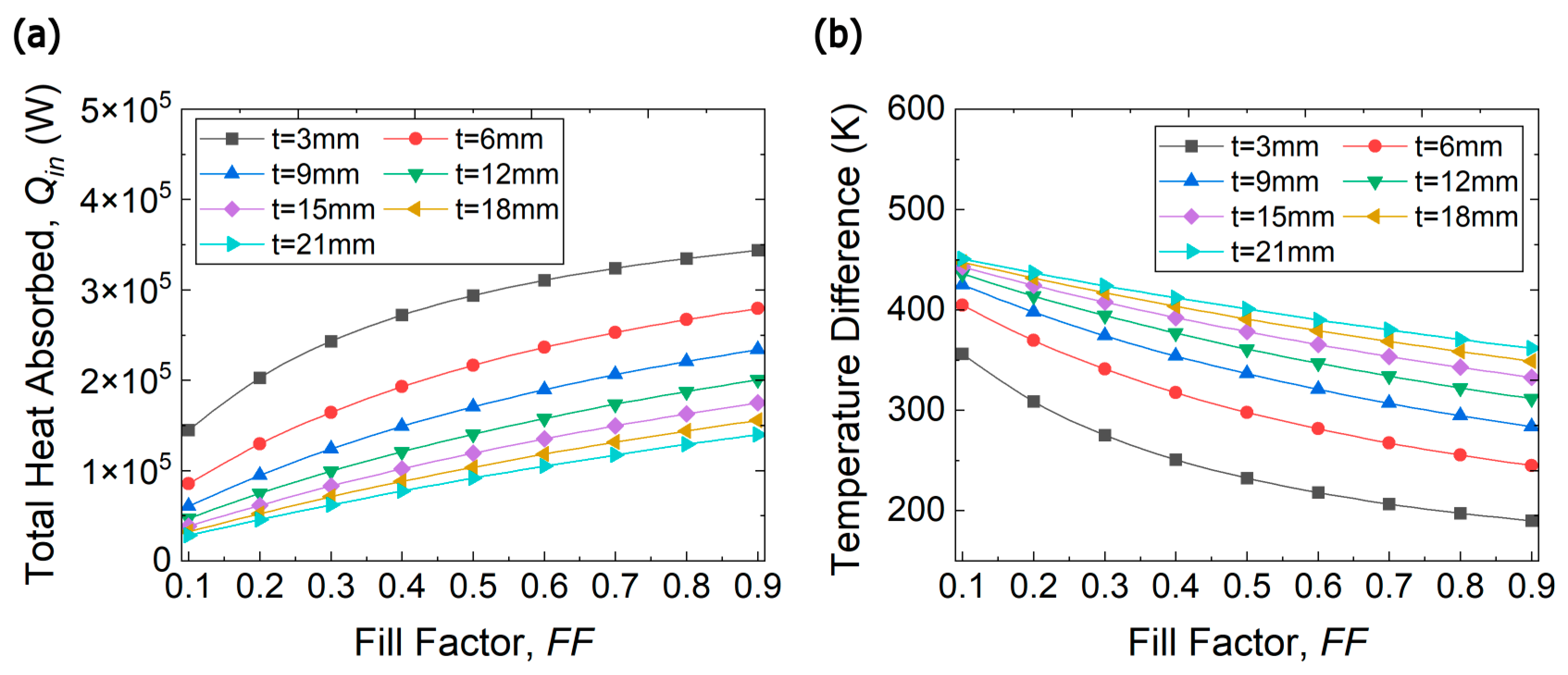
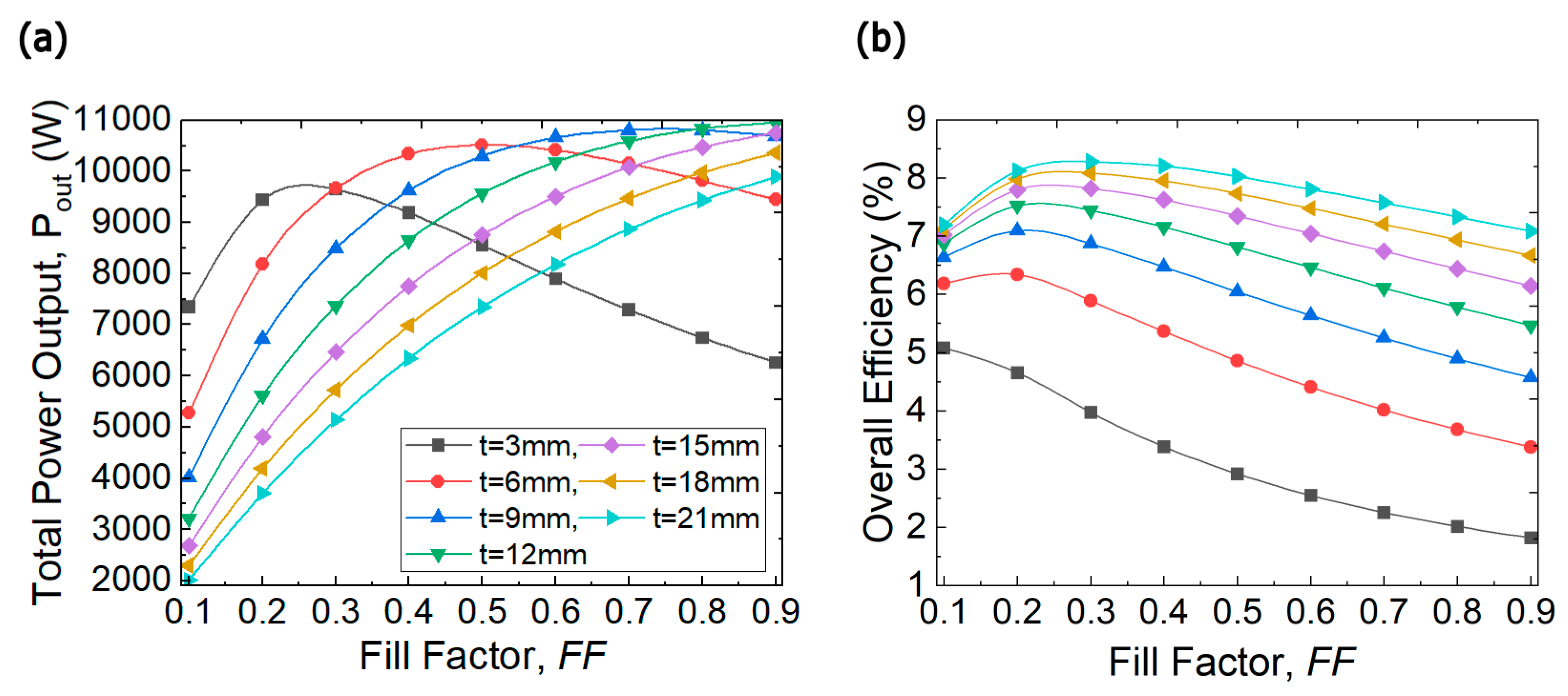
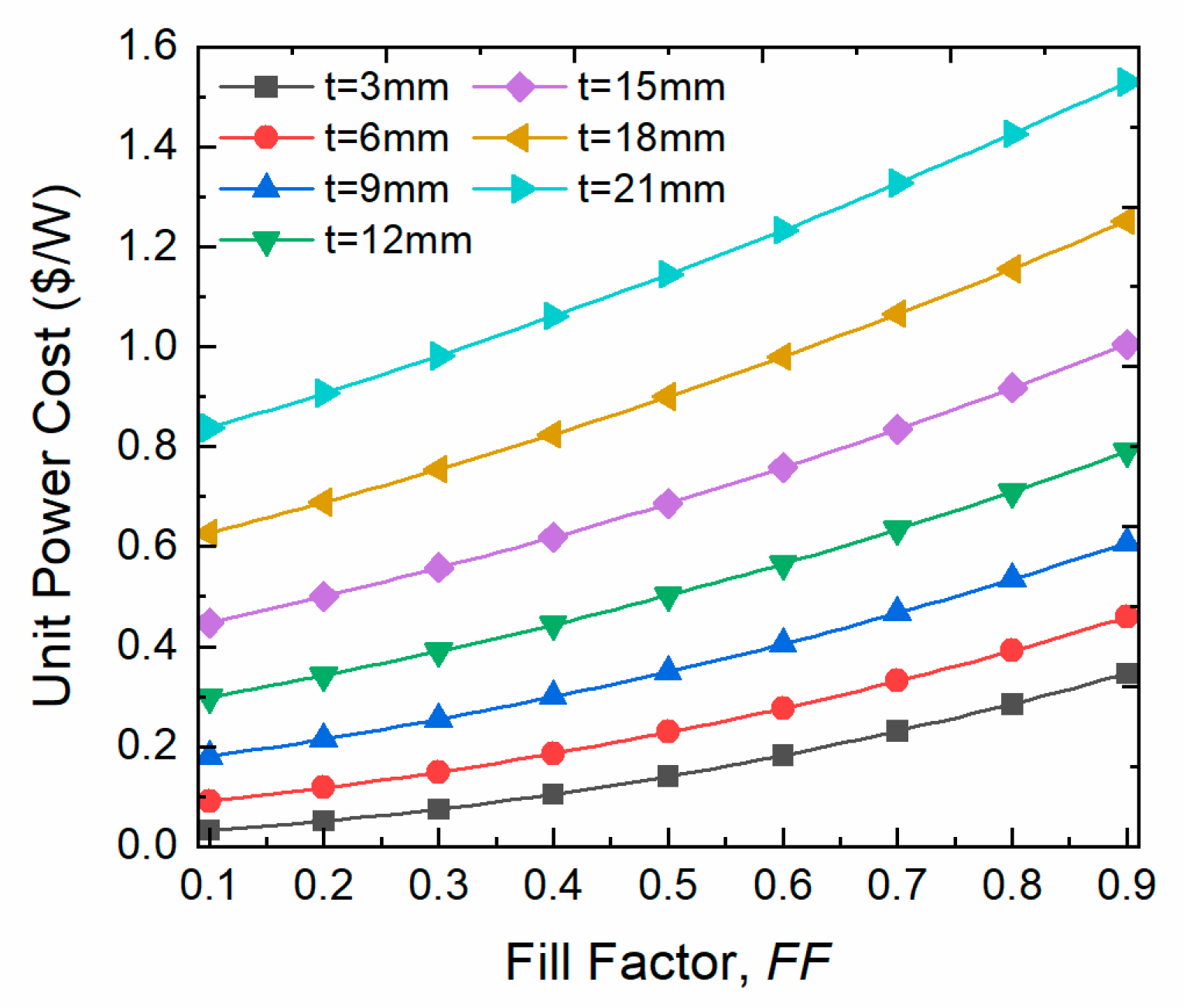

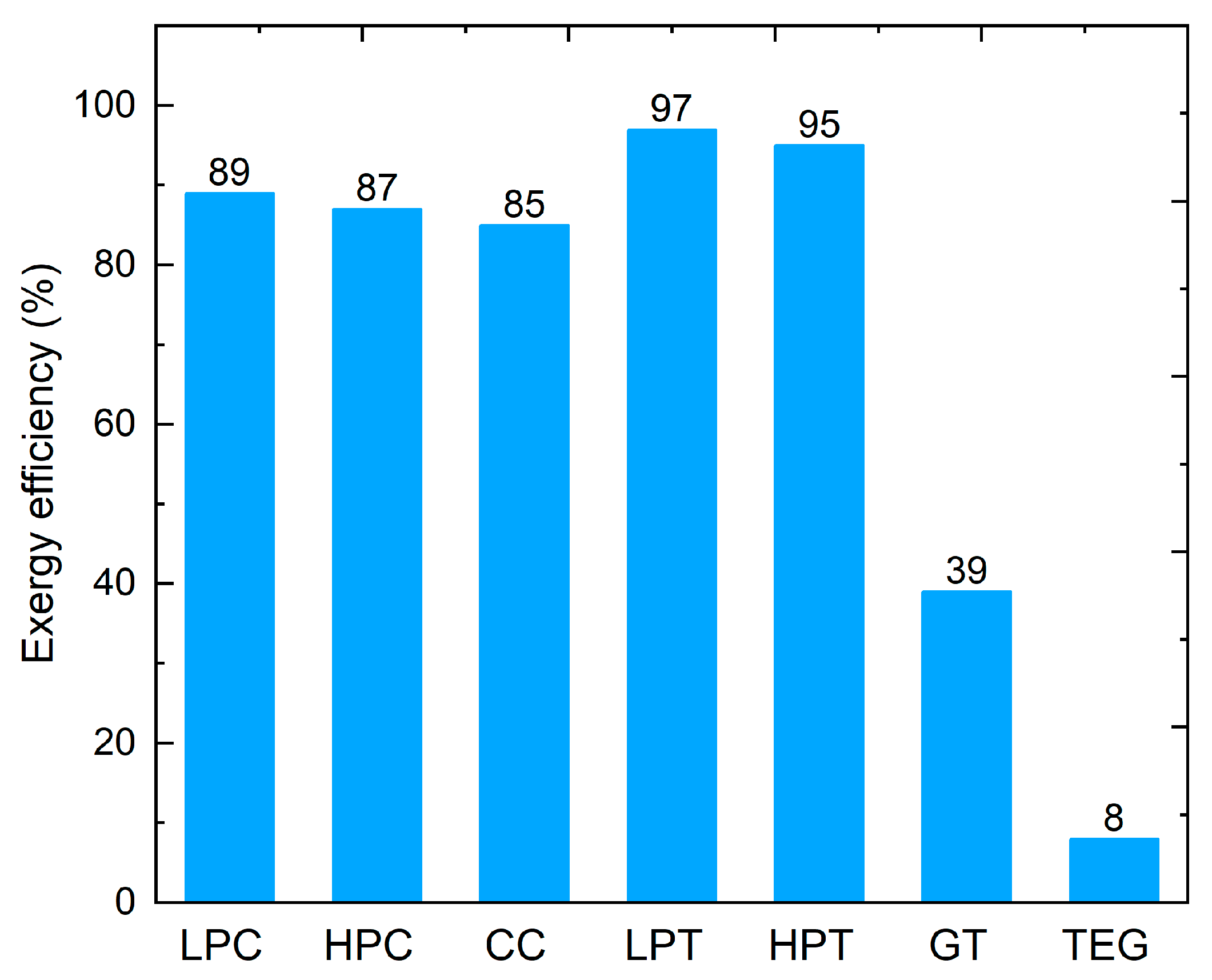
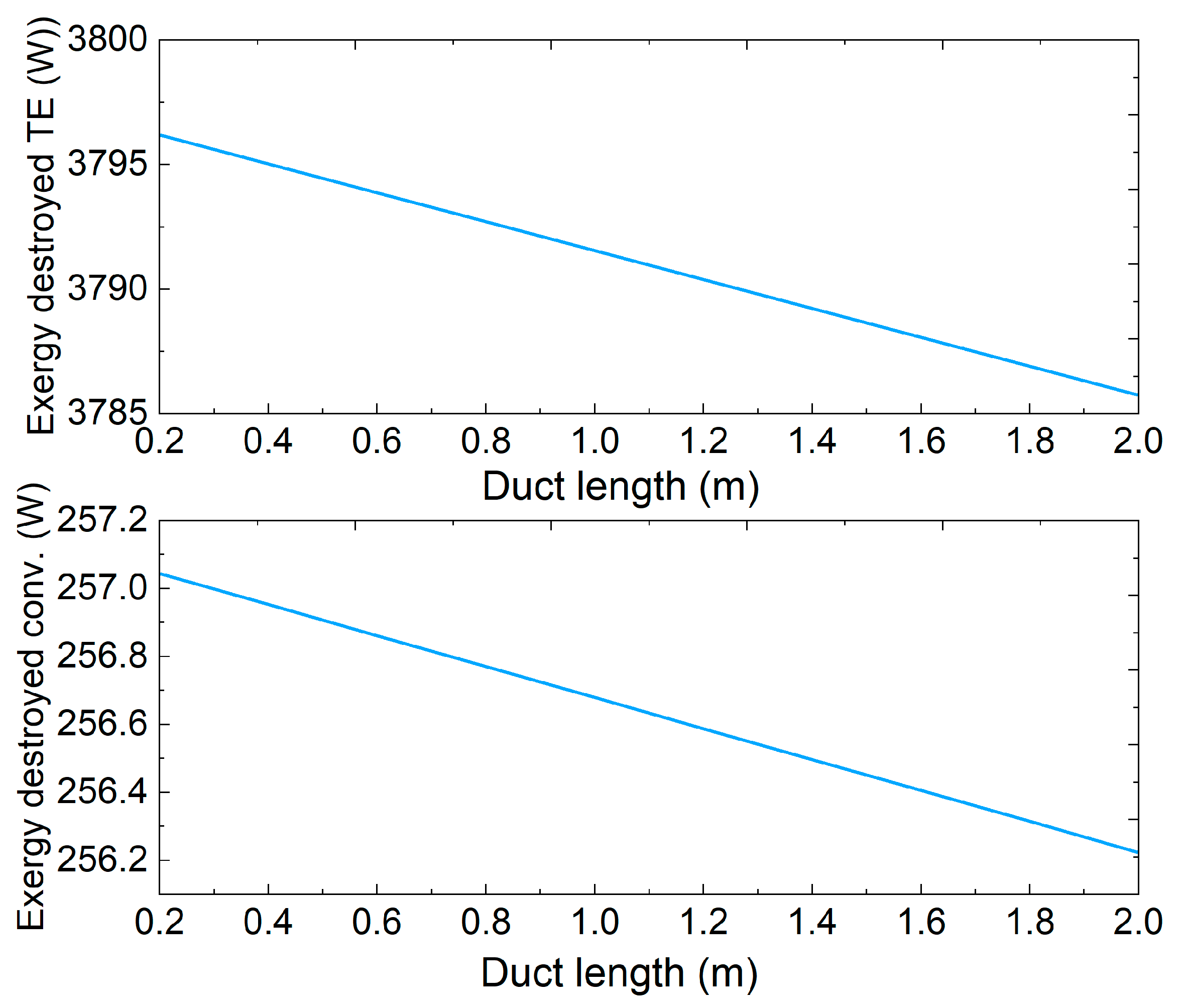
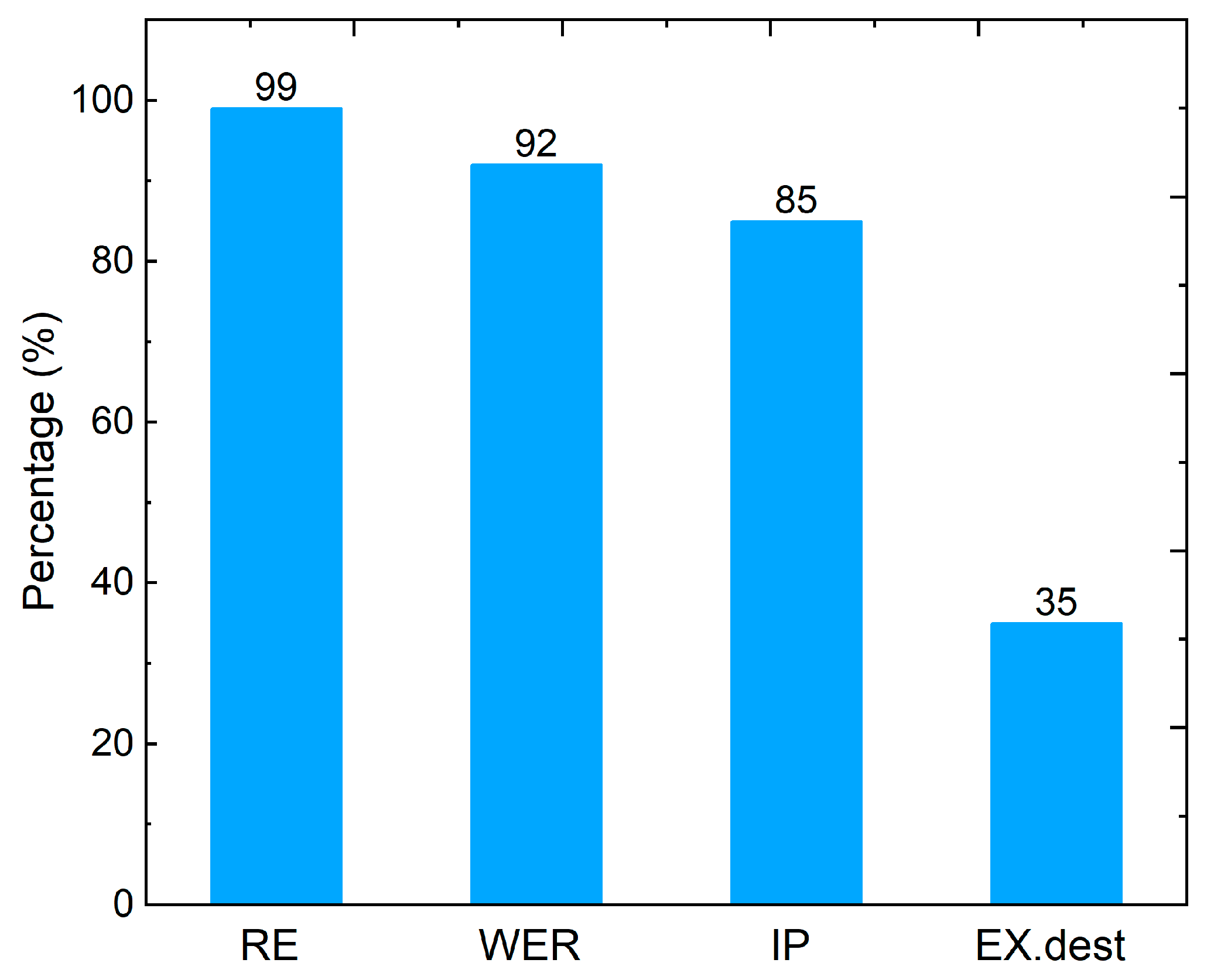
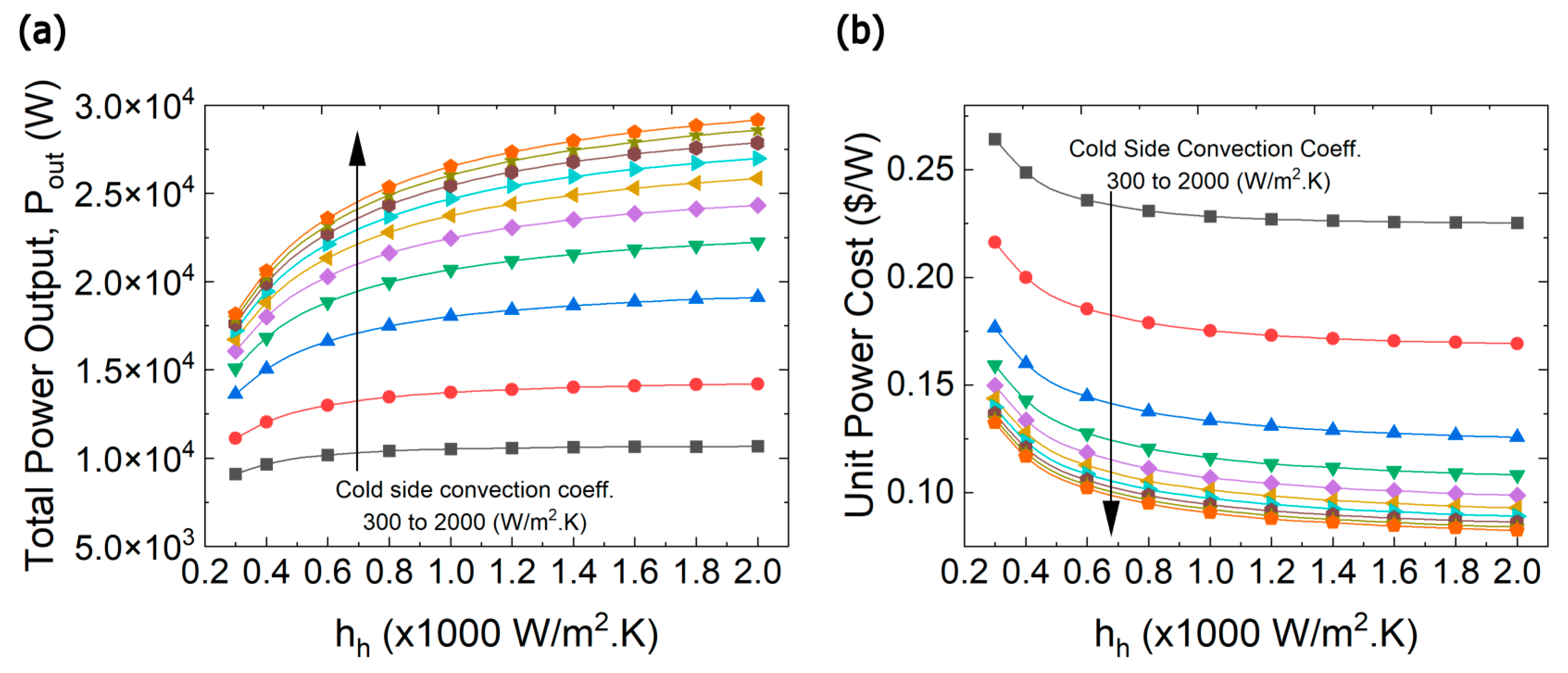
| Components | Inlet Exergy (MW) | Outlet Exergy (MW) | Exergy Efficiency (%) |
|---|---|---|---|
| LPC | 11.62 | 10.33 | 89 |
| HPC | 70.82 | 63.03 | 87 |
| CC | 174.18 | 148.27 | 85 |
| HPT | 148.27 | 146.65 | 97 |
| LPT | 85.56 | 82.84 | 95 |
Disclaimer/Publisher’s Note: The statements, opinions and data contained in all publications are solely those of the individual author(s) and contributor(s) and not of MDPI and/or the editor(s). MDPI and/or the editor(s) disclaim responsibility for any injury to people or property resulting from any ideas, methods, instructions or products referred to in the content. |
© 2023 by the authors. Licensee MDPI, Basel, Switzerland. This article is an open access article distributed under the terms and conditions of the Creative Commons Attribution (CC BY) license (https://creativecommons.org/licenses/by/4.0/).
Share and Cite
Alsaghir, A.M.; Bahk, J.-H. Performance Optimization and Exergy Analysis of Thermoelectric Heat Recovery System for Gas Turbine Power Plants. Entropy 2023, 25, 1583. https://doi.org/10.3390/e25121583
Alsaghir AM, Bahk J-H. Performance Optimization and Exergy Analysis of Thermoelectric Heat Recovery System for Gas Turbine Power Plants. Entropy. 2023; 25(12):1583. https://doi.org/10.3390/e25121583
Chicago/Turabian StyleAlsaghir, Ahmad M., and Je-Hyeong Bahk. 2023. "Performance Optimization and Exergy Analysis of Thermoelectric Heat Recovery System for Gas Turbine Power Plants" Entropy 25, no. 12: 1583. https://doi.org/10.3390/e25121583







